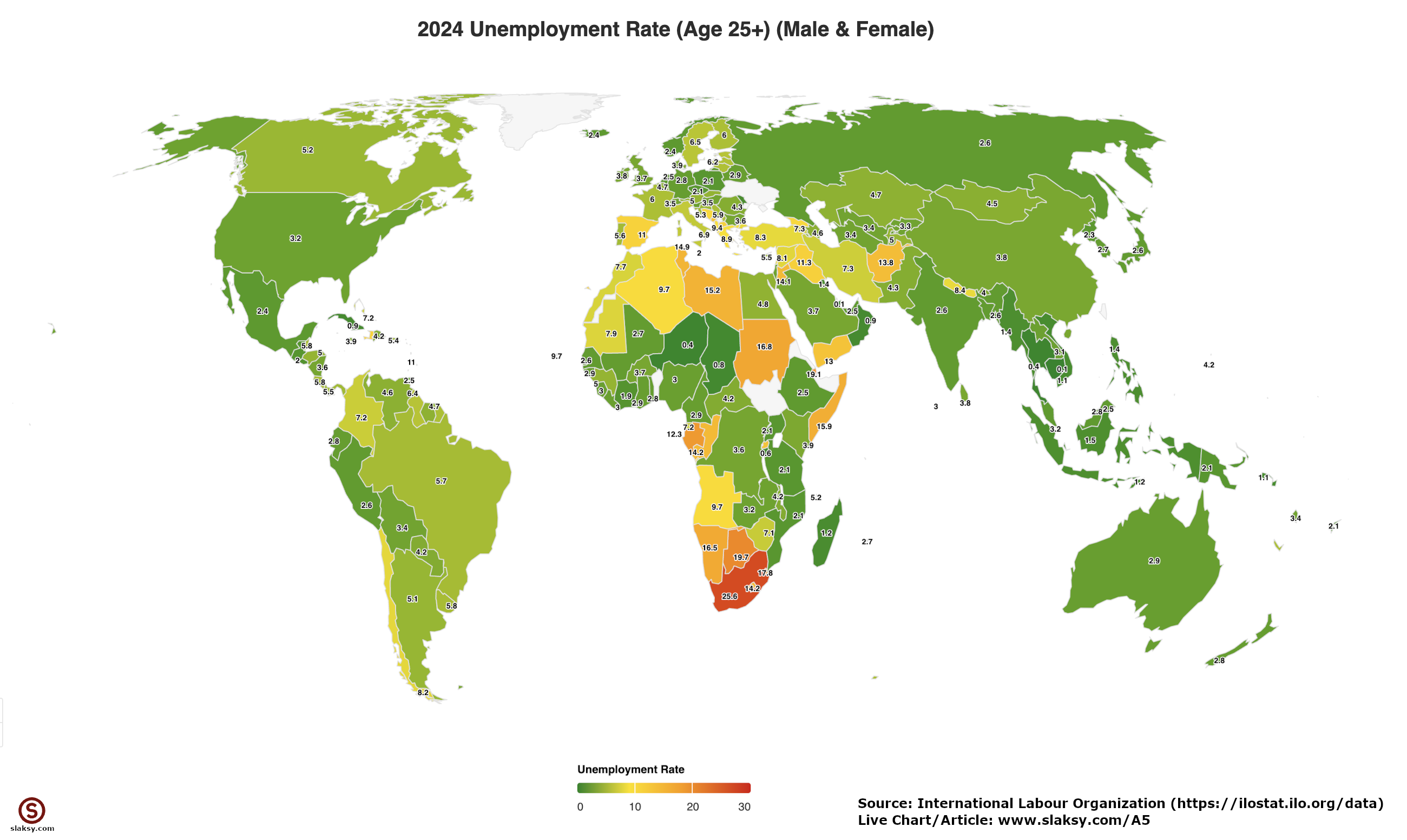Global Map of 2024 Unemployment Rates


Marcus Rodriguez
Historical Geography Expert
Marcus Rodriguez specializes in historical cartography and geographic data analysis. With a background in both history and geography, he brings unique...
Geographic Analysis
What This Map Shows
The "Global Map of 2024 Unemployment Rates" provides a comprehensive overview of the unemployment landscape across different countries and regions. This visualization highlights the estimated unemployment rates for the year 2024, allowing us to compare economic health and labor market conditions on a global scale. The map uses color coding to represent varying levels of unemployment, enabling viewers to quickly discern which areas face significant challenges and which are faring better.
Deep Dive into Unemployment Rates
Unemployment is more than just a statistic; it reflects broader economic conditions, social stability, and future growth potential. The unemployment rate is defined as the percentage of the labor force that is jobless and actively seeking employment. It’s a critical indicator of economic health, often influenced by factors such as economic policies, global market conditions, and local industry developments.
Interestingly, the global unemployment rate is not uniform. Some regions experience chronic unemployment, while others boast low rates due to robust economies. For example, countries in Northern Europe, such as Denmark and Sweden, typically report unemployment rates around 4-6%, supported by strong social safety nets and effective labor market policies. In contrast, regions like sub-Saharan Africa often face rates exceeding 10%, driven by structural issues, such as limited job creation and high population growth.
In 2024, emerging economies are expected to see varied impacts from global economic shifts. Countries like India and Vietnam have been experiencing rapid economic growth, which has helped reduce unemployment rates in recent years. However, these nations also face challenges, such as underemployment and informal labor markets that complicate the true picture of employment.
Interestingly, the COVID-19 pandemic significantly impacted unemployment rates worldwide. Many countries saw spikes in unemployment due to lockdown measures and economic slowdowns. As we move into 2024, the recovery trajectory varies widely, with some nations rebounding quickly while others struggle with lingering effects.
Additionally, technology continues to reshape the labor market. Automation and artificial intelligence are transforming industries, leading to job displacement in some sectors while creating new opportunities in others. This dual effect can be seen in the tech-heavy economies of the United States and parts of Europe, where unemployment rates remain low despite significant changes in job types.
Regional Analysis
Examining the map, we can identify distinct regional patterns. In North America, the United States is projected to experience an unemployment rate of around 3.8%, reflecting a recovering economy bolstered by robust job creation in tech and health sectors. However, Canada may see slightly higher rates due to its reliance on natural resources, which are subject to global market fluctuations.
Looking at Europe, Western countries like Germany and the Netherlands maintain low unemployment rates, often under 5%, thanks to strong labor policies and diversified economies. Conversely, Southern European countries like Greece and Spain continue to grapple with higher unemployment rates, hovering around 12-14%, as they recover from past economic crises.
In Asia, countries like Japan and South Korea benefit from advanced technology sectors, leading to low unemployment rates. However, nations such as Afghanistan and Yemen face staggering rates due to ongoing conflict and instability, often surpassing 20%. This stark contrast highlights the significant geopolitical factors influencing employment.
Significance and Impact
Understanding unemployment rates is crucial, as they not only reflect economic health but also have profound social implications. High unemployment can lead to increased poverty, social unrest, and a decline in overall quality of life. Conversely, low unemployment rates often correlate with higher consumer spending and economic growth.
As we look toward the future, several trends emerge. The rise of remote work may alter traditional employment landscapes, enabling a more flexible workforce but also raising questions about job security and benefits. Moreover, economic policies aimed at job creation and workforce development will be critical in addressing the disparities highlighted in the map.
In conclusion, the "Global Map of 2024 Unemployment Rates" serves as a vital tool for understanding the complexities of labor markets worldwide. By analyzing these numbers, we can better grasp the challenges and opportunities that lie ahead, fostering informed discussions about economic policy and social welfare initiatives.
Visualization Details
- Published
- October 12, 2025
- Views
- 26
Comments
Loading comments...